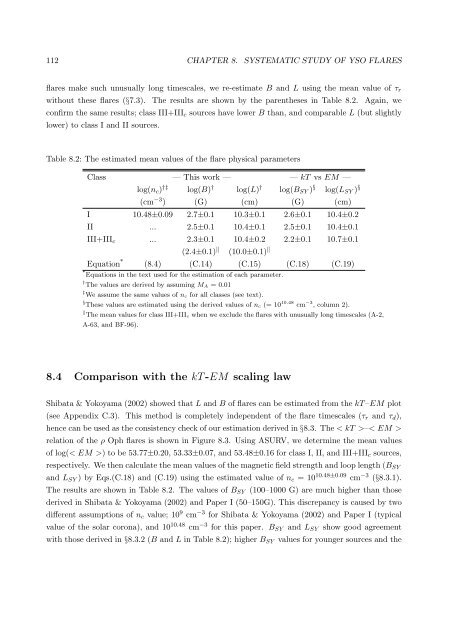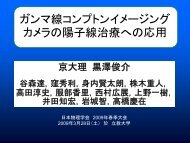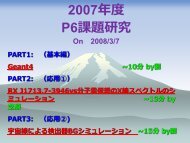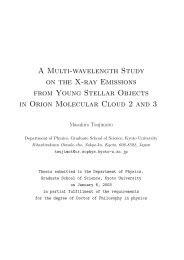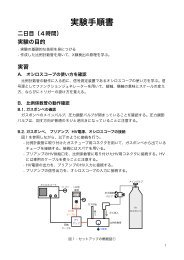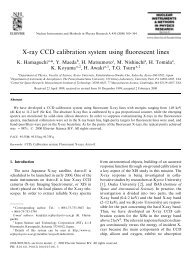X-ray Study of Low-mass Young Stellar Objects in the ρ Ophiuchi ...
X-ray Study of Low-mass Young Stellar Objects in the ρ Ophiuchi ...
X-ray Study of Low-mass Young Stellar Objects in the ρ Ophiuchi ...
Create successful ePaper yourself
Turn your PDF publications into a flip-book with our unique Google optimized e-Paper software.
112 CHAPTER 8. SYSTEMATIC STUDY OF YSO FLARESflares make such unusually long timescales, we re-estimate B and L us<strong>in</strong>g <strong>the</strong> mean value <strong>of</strong> τ rwithout <strong>the</strong>se flares (§7.3). The results are shown by <strong>the</strong> paren<strong>the</strong>ses <strong>in</strong> Table 8.2. Aga<strong>in</strong>, weconfirm <strong>the</strong> same results; class III+III c sources have lower B than, and comparable L (but slightlylower) to class I and II sources.Table 8.2: The estimated mean values <strong>of</strong> <strong>the</strong> flare physical parametersClass — This work — — kT vs EM —log(n c ) †‡ log(B) † log(L) † log(B SY ) § log(L SY ) §(cm −3 ) (G) (cm) (G) (cm)I 10.48±0.09 2.7±0.1 10.3±0.1 2.6±0.1 10.4±0.2II ... 2.5±0.1 10.4±0.1 2.5±0.1 10.4±0.1III+III c ... 2.3±0.1 10.4±0.2 2.2±0.1 10.7±0.1(2.4±0.1) ‖ (10.0±0.1) ‖Equation * (8.4) (C.14) (C.15) (C.18) (C.19)* Equations <strong>in</strong> <strong>the</strong> text used for <strong>the</strong> estimation <strong>of</strong> each parameter.† The values are derived by assum<strong>in</strong>g M A = 0.01‡ We assume <strong>the</strong> same values <strong>of</strong> n c for all classes (see text).§ These values are estimated us<strong>in</strong>g <strong>the</strong> derived values <strong>of</strong> n c (= 10 10.48 cm −3 , column 2).‖ The mean values for class III+III c when we exclude <strong>the</strong> flares with unusually long timescales (A-2,A-63, and BF-96).8.4 Comparison with <strong>the</strong> kT -EM scal<strong>in</strong>g lawShibata & Yokoyama (2002) showed that L and B <strong>of</strong> flares can be estimated from <strong>the</strong> kT –EM plot(see Appendix C.3). This method is completely <strong>in</strong>dependent <strong>of</strong> <strong>the</strong> flare timescales (τ r and τ d ),hence can be used as <strong>the</strong> consistency check <strong>of</strong> our estimation derived <strong>in</strong> §8.3. The < kT >–< EM >relation <strong>of</strong> <strong>the</strong> <strong>ρ</strong> Oph flares is shown <strong>in</strong> Figure 8.3. Us<strong>in</strong>g ASURV, we determ<strong>in</strong>e <strong>the</strong> mean values<strong>of</strong> log(< EM >) to be 53.77±0.20, 53.33±0.07, and 53.48±0.16 for class I, II, and III+III c sources,respectively. We <strong>the</strong>n calculate <strong>the</strong> mean values <strong>of</strong> <strong>the</strong> magnetic field strength and loop length (B SYand L SY ) by Eqs.(C.18) and (C.19) us<strong>in</strong>g <strong>the</strong> estimated value <strong>of</strong> n c = 10 10.48±0.09 cm −3 (§8.3.1).The results are shown <strong>in</strong> Table 8.2. The values <strong>of</strong> B SY (100–1000 G) are much higher than thosederived <strong>in</strong> Shibata & Yokoyama (2002) and Paper I (50–150G). This discrepancy is caused by twodifferent assumptions <strong>of</strong> n c value; 10 9 cm −3 for Shibata & Yokoyama (2002) and Paper I (typicalvalue <strong>of</strong> <strong>the</strong> solar corona), and 10 10.48 cm −3 for this paper. B SY and L SY show good agreementwith those derived <strong>in</strong> §8.3.2 (B and L <strong>in</strong> Table 8.2); higher B SY values for younger sources and <strong>the</strong>


